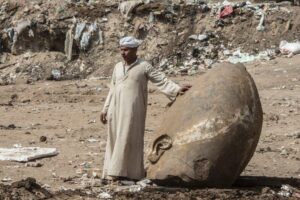



Among his many other noble titles, Pharaoh Ramses II could soon add one more honorific: the ultimate slumdog millionaire.
Archaeologists have discovered a massive statue that likely depicts the ancient Egyptian ruler submerged in the groundwater of a Cairo area slum. The sculpture, believed to be some 3,000 years old, lies in Matariya, near the ruins of the ancient city of Heliopolis.


A team of Egyptian and German researchers began excavating the quartzite sculpture, estimated to stand 26 to 30 feet tall, on Thursday.
he discovery caps an archeological study of the area that had begun in 2012, CNN reports. The dig was just wrapping up having found little else of great import.
The statue “was in an area that was almost completely investigated,” Dietrich Raue from the University of Leipzig, one of the partners in the dig, told CNN. “We thought [the pit] would be empty without any features … so that was a great surprise.”
Ramses II, also known as Ramses the Great, ruled from 1279 to 1213 BCE. In that time, he greatly expanded the reach of the Egyptian empire, to as far east as modern-day Syria and as far south as current-day Sudan, according to National Geographic.


There’s something weird about this photograph.


Caution: May induce a “transcendental experience.”


There is scientific-backed research that proves.


Remy Ma, pay attention. It looks.


It’s the stuff of science fiction:.


If you want to skip the.


Scientists, environmentalists and Democratic lawmakers pounced.


Dr. John Aucott loves to let.


Will Smith lived out a long-held.
Leave a Comment